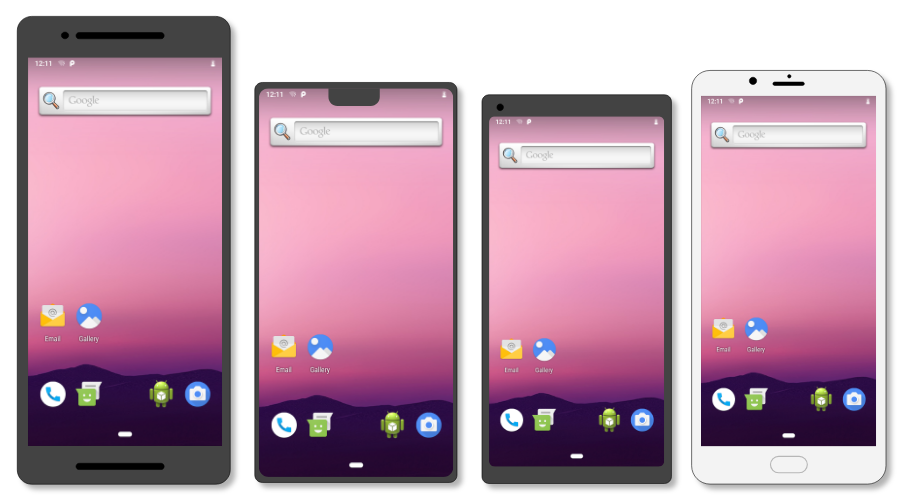Podstawowy obraz systemu (GSI) to czysta implementacja Androida z niezmodyfikowanym kodem Projektu Android Open Source (AOSP), którą można uruchamiać na różnych urządzeniach z Androidem.
Deweloperzy aplikacji mogą instalować i uruchamiać najnowsze pliki GSI Androida, aby testować aplikacje na różnych urządzeniach z Androidem i za pomocą plików GSI z różnych etapów wydania systemu Android, w tym wersji przedpremierowych i beta. Dodanie GSI do procesów weryfikacji i testowania może przynieść Ci dodatkowe korzyści:
- szerszy zakres testów na większej liczbie rzeczywistych urządzeń;
- Więcej czasu na rozwiązanie problemów ze zgodnością aplikacji
- Więcej możliwości rozwiązywania zgłaszanych przez deweloperów aplikacji problemów ze zgodnością z Androidem
Projekt GSI jest otwarty i pomaga ulepszać ekosystem Androida, ponieważ zapewnia więcej sposobów na poprawę jakości aplikacji i systemu operacyjnego przed każdą wersją Androida.

Obrazy GSI zawierają te same podstawowe funkcje systemowe na wszystkich urządzeniach, na których są zainstalowane. Inaczej mówiąc, GSI nie zawiera dostosowań producenta urządzenia. Z tego powodu w tych sytuacjach mogą wystąpić różnice w zachowaniu:
- Interakcje z interfejsem
- Przepływy pracy, które wymagają nowszych funkcji sprzętowych
Sprawdzanie zgodności urządzenia
Obrazy GSI mogą działać tylko na urządzeniach o tych cechach:
- Program rozruchowy jest odblokowany.
- W pełni zgodny z Treble.
- Wprowadzone na rynek z Androidem 9 (API na poziomie 28) lub nowszym. Urządzenia, które zostały uaktualnione do Androida 9 z wcześniejszej wersji, mogą obsługiwać GSI lub nie.
Aby sprawdzić, czy Twoje urządzenie może korzystać z GSI i którą wersję systemu operacyjnego GSI należy zainstalować, wykonaj te czynności:
Sprawdź, czy urządzenie obsługuje technologię Treble. W tym celu uruchom to polecenie:
adb shell getprop ro.treble.enabled
Jeśli odpowiedź to
false, urządzenie nie jest zgodne z GSI i nie należy kontynuować. Jeśli odpowiedź totrue, przejdź do następnego kroku.Sprawdź, czy jest obsługiwana zgodność między wersjami. W tym celu uruchom to polecenie:
adb shell cat /system/etc/ld.config.version_identifier.txt \ | grep -A 20 "\[vendor\]"
W danych wyjściowych w sekcji
[vendor]poszukajnamespace.default.isolated.Jeśli wartość tego atrybutu to
true, urządzenie w pełni obsługuje pakiet Vendor Native Development Kit (VNDK) i może używać dowolnej wersji systemu operacyjnego GSI nowszej niż wersja systemu operacyjnego na urządzeniu. W miarę możliwości używaj najnowszej dostępnej wersji systemu operacyjnego GSI.Jeśli wartość atrybutu to
false, urządzenie nie jest w pełni zgodne z VNDK i może używać tylko obrazu GSI dla tej samej wersji systemu operacyjnego na urządzeniu. Na przykład urządzenie z Androidem 10 (wersja interfejsu API 29), które nie jest zgodne z VNDK, może wczytać tylko obraz GSI Androida 10.Typ architektury procesora GSI musi być zgodny z architekturą procesora urządzenia. Aby znaleźć odpowiednią architekturę procesora dla obrazu GSI, uruchom to polecenie:
adb shell getprop ro.product.cpu.abi
Na podstawie wyniku określ, którego obrazu GSI użyć podczas flashowania urządzenia. Na przykład na Pixelu 5 dane wyjściowe wskazywałyby, że architektura procesora to
arm64-v8a, więc użyjesz typuarm64obrazu GSI.
Pobieranie obrazów GSI
Istnieje kilka sposobów uzyskania GSI, w zależności od potrzeb związanych z programowaniem:
- W przypadku wersji GSI Androida w wersji zapoznawczej i GSI Androida z GMS pobierz obrazy ze strony z wersjami GSI.
Gotowe obrazy GSI bez aplikacji GMS możesz pobrać ze strony CI AOSP:
Aby utworzyć obrazy GSI Androida bez GMS, pobierz kod źródłowy z AOSP i utwórz obrazy GSI.
Instalowanie GSI
Instalacja GSI zależy od urządzenia. Skontaktuj się z producentem urządzenia, aby uzyskać informacje o dokładnych narzędziach i procedurach. W przypadku urządzeń Google Pixel, takich jak Pixel 3 i nowsze, można zainstalować aplikację na kilka sposobów:
- Ręczne instalowanie obrazów GSI: zobacz Wymagania dotyczące instalowania obrazów GSI
- Korzystanie z dynamicznej aktualizacji systemu (DSU) na urządzeniach z Androidem 10 lub nowszym: zobacz stronę Dynamiczne aktualizacje systemu.
Prześlij opinię
Obrazy GSI mają pomóc w weryfikacji aplikacji na Androidzie. Dziękujemy za Twoją opinię na temat obrazów, narzędzi i procesu korzystania z obrazów GSI na urządzeniach.
Aby zgłosić błędy lub poprosić o dodanie funkcji, użyj komponentu do śledzenia problemów w przypadku obrazów GSI.

